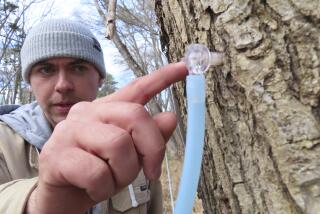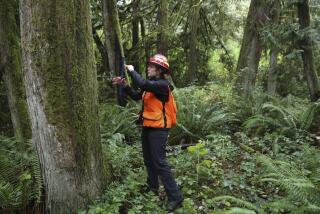Sweet Return From Syrup May Be Heading North
- Share via
FERRISBURGH, Vt. — Sam Cutting Sr. eases from his pickup, lumbers stiffly in blue jeans and suspenders up a hillside, and cranes his neck toward the maple grove that nearly broke his heart.
The crowns are finally spreading again. But some 3-foot-thick trunks are sheered 30 feet from the ground. Dead branches lie scattered in piles like drying bones.
Cutting’s sugarbush -- a syrup maker’s term of endearment for his maple woods -- is still recovering from an ice storm four years ago during a winter thaw.
“There was so much damage, you couldn’t even walk through here,” said Cutting, the 70-year-old patriarch who remains master syrup maker of a family business now run by his son. “I just thought: I’ve had it. I’m never going to sugar again.”
He was wrong. The 30-acre leased sugarbush is finally returning to its earlier seasonal output of about 300 gallons of syrup. For the Cuttings, though, it was a sour taste of what global warming from man-made greenhouse gases could do in coming generations.
“We’ve always had worries with the maples. I’ve seen bugs and drought,” Cutting said. “When it gets to man-made things, it’s more of a worry.”
He may be right to worry. Government-sponsored researchers have found statistical evidence that cold-loving maples yield less sap in warmer winters. In keeping with that data, an Associated Press analysis of syrup production over the past eight decades shows a decline in every New England state but Maine -- the only one to buck the warming trend.
There is no definitive scientific proof yet that warmer temperatures take even part of the blame. But University of New Hampshire forester Rock Barrett, who oversaw the government report, fears that it may already be too late for maple country.
It is said that roughly one in four Vermont trees is a sugar maple. Vermonters made almost 60% of New England’s 850,000 gallons of syrup this year, according to federal farm data.
Every year, as winter begins to melt away, Vermont’s sugarhouses come back to life. They puff thick white smoke from stainless steel evaporators that boil sap down to syrup. Punctuated by vacuum gauges, sap-carrying plastic tubing -- a technology that is replacing suspended buckets -- snakes through thick woods to collection tubs. Vermont kids, as always, freeze maple treats in the snow.
In Ferrisburgh, in western Vermont about 60 miles from the Canadian border, the Cutting grandchildren are already lending a hand in the family business. But the adults wonder if it will eventually be lost to future generations.
“It would be devastating because it has been such a strong part of our heritage,” said Cutting’s son, also named Sam.
Already, over recent decades, most expansion in syrup production has occurred in the north, in colder Quebec. In the last 10 years alone, yearly production there has doubled to satisfy a booming market, now eclipsing the United States fivefold, according to the North American Maple Syrup Council.
Over the last 80 years, New England’s typical syrup output has dropped by more than half, from more than 1.6 million gallons a year to less than 800,000, the AP analysis shows. Syrup has dwindled to a $22-million annual regional business, according to the U.S. Department of Agriculture.
Clearly, social and economic changes, including the shift from an agrarian society and the advent of popular syrup substitutes, explain much of the maple industry’s contraction. But the region’s average annual temperature -- combined with upstate New York’s -- also climbed nearly 1 degree during the 20th century, possibly further depressing syrup flow. Vermont has warmed by 1.6 degrees, the climate data shows.
Only Maine has cooled, slipping a yearly average of nearly half a degree -- perhaps because of its long coast, vast forests or other differences in geography and land use. Meanwhile, Maine’s syrup production has exploded from less than 12,000 gallons a year through most of the 1980s to 230,000 gallons this year. The boom stems partly from an invasion of Quebec sugar makers working Maine forests, but temperature may also play a part, the research suggests.
In another possible hint of the future, some New England syrup makers have noticed an earlier sugaring season over past decades. In Vermont, it now typically starts a few weeks sooner, in late February.
Without more control of man-made greenhouse gases, New England’s average yearly temperature could rise by 6 to 10 degrees over the next century, according to the report sponsored last year by the federal government’s Global Change Research Program.
Seemingly slight annual shifts in temperature can transform climate and landscape. After all, parts of New England were buried under 2 miles of ice about 20,000 years ago -- when the annual global average temperature was just 10 to 12 degrees colder than now. The warming forecast in the next century would make Boston’s climate more like today’s in Richmond, Va., or Atlanta, the federal researchers say.
Their prediction unsettles Bill Eva, president of the New Hampshire Maple Producers Assn. “They make very little syrup in Virginia,” he said.
Many sugar makers are unruffled. They say that even if the predictions are right, changes will unfold gradually over decades, with limited effects on them or their children.
“I haven’t really seen any deterioration in the health of our trees because of warm weather, and I haven’t seen any real decline in sap production,” said third-generation mapleman Hank Peterson of Londonderry, N.H. “It’s the old Yankee saying that ‘if it ain’t broke, don’t fix it.’ ”
New England governors and eastern Canadian premiers have set a goal of reducing the region’s greenhouse gas output to at least 10% below 1990 emissions by the year 2020. Activists are pressing for more fuel-efficient cars and cleaner energy generation.
Even in Quebec, where sap still gushes like Texas oil, there is disquiet.
“We could lose the industry totally,” said Luc Lussier, a Quebec syrup distributor who is president of the North American Maple Syrup Council.
More to Read
Sign up for Essential California
The most important California stories and recommendations in your inbox every morning.
You may occasionally receive promotional content from the Los Angeles Times.













